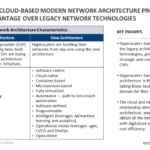Hyperscalers are reimagining how networks are built, owned and operated
Hyperscaler-built networks will look very different from traditional networks
Hyperscalers are building end-to-end networks that embody all the attributes and characteristics coveted by communication service providers (CSPs) as part of their digital transformations. The most significant differences are in the software stack and the access layer, where new technologies enable hyperscalers to build dense mesh networks in unlicensed and/or shared spectrum bands and build out low Earth orbit (LEO) satellite overlays for access and backhaul. Mesh networks will likely be used to provide low-cost, wireless-fiber-like connectivity in urban and suburban environments, while satellites will primarily be leveraged to provide connectivity to rural and remote environments.
Hyperscalers are starting from scratch, completely reimagining how networks should be built and operated. Their clouds, numerous network-related experiments over the past decade, plus the raft of new network-related technologies on the road map will enable hyperscalers to build asset-light, automated networks at a fraction of the cost of traditional networks.
Hyperscaler networks will cost a fraction of traditional networks
TBR estimates hyperscaler networks cost 50% to 80% less to build than traditional networks (excludes the cost of spectrum, which would make the cost differential even more pronounced because hyperscalers will primarily leverage unlicensed and shared spectrum, which is free to use). Most of the cost savings stems from innovations, such as mesh networking, carrier aggregation, LEO satellites and integrated access-backhaul, that enable significantly less wired infrastructure to be deployed in the access layer for backhaul and last-mile connection purposes.
For example, Meta’s Terragraph mesh access point can autonomously hop signals through multiple other access points before sending the data through the nearest available backhaul conduit. In the traditional architecture, some form of backhaul would need to connect to each access point to backhaul the traffic. Mesh signals could also be backhauled through LEO satellites, further limiting the need to deploy wired infrastructure in the access layer, which is one of the most significant costs of traditional networks.
Another key area of cost savings stems from cutting out certain aspects of the traditional value chain. By open-sourcing some innovations, such as hardware designs, hyperscalers can foster a vibrant ecosystem of ODMs to manufacture white boxes to compose the physical network. The white-boxing of ICT hardware can lead to cost savings of up to 50% compared to proprietary, purpose-built appliances.
Hyperscaler disruption portends structural changes to the telecom industry through this decade
The technological and business model disruption hyperscalers are bringing into the telecom industry portends significant challenges for incumbent vendors and CSPs. TBR sees the scope of disruption becoming acute in the second half of this decade, likely prompting waves of M&A that will reshape the global landscape. CSPs will engage in M&A to stay relevant and financially sound, while incumbent vendors scramble to evolve as their primary business model (selling proprietary hardware and/or software and attached services) is increasingly marginalized and eventually becomes obsolete as hyperscaler innovations spread through the industry.
Hyperscalers do not want to become telecom operators; they want to leverage networks to obtain data and drive their other digital businesses
Hyperscalers are in the data business; providing network connectivity is a means to that end
Hyperscalers are building large-scale networks to drive forward and support their big-picture strategies, which revolve around building out their respective metaverses and supporting a wide range of new digital business models that will be enabled by new technologies such as 5G, edge computing and AI.
To that end, hyperscalers have a vested interest in ensuring the entire world is blanketed with high-speed, unencumbered, intelligent, low-cost connectivity. The economic justification to build the network is driven by the need for hyperscalers to gather and process new types of data to drive these new digital business initiatives. TBR notes that this business case is completely different from CSPs’ business case, which monetizes the network access rather than the data that comes over the network. The hyperscaler model emphasizes giving away low-cost or free connectivity and monetizing the data that comes through the network. The hyperscaler model is far more valuable than the traditional connectivity model and will likely ultimately become the predominant business model for connectivity.
CSPs sit on vast data lakes and have for many years. These data lakes contain valuable information about subscribers, endpoint devices, real-time location and tracking, and other metrics that are of critical importance for some of the digital business ideas hyperscalers want to commercialize, such as drone package delivery and autonomous vehicles. Owning more of the physical network infrastructure and the core software stack puts hyperscalers in a prime position to capture and monetize this data.
TBR notes that this strategy is already in use in the telecom industry in various places in the world. For example, Reliance Jio and Rakuten are using this strategy in India and Japan, respectively. In both cases, connectivity is given away for free or at a significantly lower cost compared to rival offers, and the data generated by the connections indirectly feeds and monetizes each company’s respective digital businesses, such as advertising, financial services and e-commerce. There is significant evidence suggesting that Alphabet, Amazon, Apple, Meta Platforms and Microsoft all have strategies that are similar but of a far greater magnitude.
Hyperscalers already own and operate the largest networks in the world; the next build-out phase is the mobile core, far edge and access domains
Over two-thirds of global internet traffic traverses hyperscaler-owned network infrastructure at some point in the data’s journey. The vast majority of that traffic travels over hyperscalers’ backbone networks, which primarily comprise optical transmission systems (submarine and terrestrial long-haul optical cables), content delivery networks, and cloud (including central, regional and metro) data centers.
The domains of the network where hyperscalers have yet to dominate at scale are the mobile core, far edge and access layers, but there is mounting evidence to suggest this is changing, thanks to technological advancement and regulatory breakthroughs (e.g., the democratization of spectrum).
TBR’s Hyperscaler Digital Ecosystem Market Landscape focuses on the five primary hyperscalers in the Western world that TBR believes will own the largest, most comprehensive end-to-end digital ecosystems in the digital era. Specifically, the five hyperscalers covered in this report are Microsoft, Alphabet, Meta Platforms, Amazon and Apple. Collectively, TBR refers to these five hyperscalers under the acronym MAMAA. TBR covers the totality of the largest hyperscalers’ businesses, with an emphasis on how they are disrupting the ICT sector. Gain access to this full report, as well as our entire Telecom research, with a 60-day free trial of TBR Insight Center™.



 Technology Business Research, Inc.
Technology Business Research, Inc.
Leave a Reply
Want to join the discussion?Feel free to contribute!